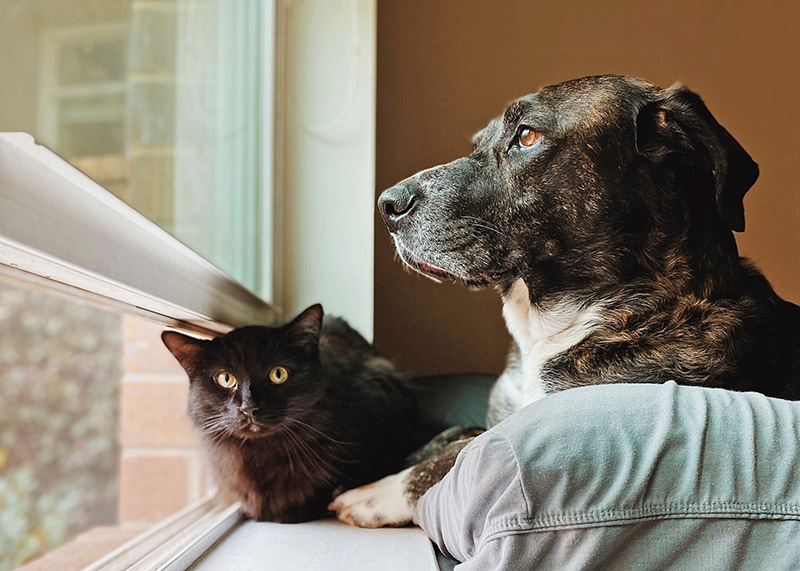Posts in Category: Senior Pet Care
Diabetes in Cats: Prevention and Treatment

Diabetes mellitus is a condition in which the body cannot properly produce or respond to the hormone insulin. Insulin regulates the amount of glucose (sugar) in the bloodstream and delivers glucose to the tissues of the body to use as energy. Diabetes results in elevated levels of glucose in the blood. The most common form of diabetes in cats is type 2 diabetes. In type 2 diabetes, glucose levels are high because cells in the body do not respond appropriately to insulin.
Diabetes is the second most common endocrine disease in cats. (The body’s endocrine system consists of several glands—in the case of diabetes, that gland is the pancreas—that make hormones, which are chemical messengers to control organs throughout the body.)
Cats are typically diagnosed with diabetes between the ages of 10 and 13 years. More cats are acquiring diabetes as the number of overweight or obese cats grows. The average cat that weighs 13 pounds or more has about four times the risk of developing diabetes as a smaller cat. Signs of diabetes can include increased thirst, increased urination, weight loss, and increased appetite.
Diagnosis
When a cat is suspected of having diabetes, a veterinarian will perform blood and urine testing. Diabetes is indicated if blood testing shows an elevated glucose level (hyperglycemia) and urine testing shows evidence of glucose in the urine (glucosuria).
Because stress in cats can lead to both hyperglycemia and glucosuria, another confirmation test called fructosamine is usually done. Fructosamine concentration reflects the average glucose concentration for the past 1 to 2 weeks and is not impacted by stress. If this test comes back as elevated, the diagnosis of diabetes is confirmed.
Treatment
Insulin is the treatment of choice for cats with diabetes. This typically requires twice daily administration. In addition, dietary management can be an important component of managing diabetes in cats. A high-protein/low-carbohydrate diet is recommended. Weight loss is also an important component of diabetic management in overweight cats. Weight loss, if attempted, should ideally be gradual, one-half percent to 1% of total body weight lost per week.

The goals of treatment are to maintain a healthy blood glucose, stop or control unintended weight loss, stop or control increased thirst and urination, and avoid hypoglycemia (low blood glucose).
Unlike dogs, cats can reach diabetic remission; these cats have near-normal blood glucose levels without receiving insulin or other blood-sugar–lowering medication. However, cats in diabetic remission require close monitoring to ensure that they do not relapse. Remission is not achievable in every diabetic cat.
Monitoring
Blood glucose curves are used to monitor response to insulin dosing. If a blood glucose curve is performed at home, pet owners measure the first blood glucose reading before the insulin injection. Then, they test every 2 to 4 hours until the next dose of insulin, depending on the type of insulin used. Performing curves at home eliminates the stress of coming to the clinic, which can affect the accuracy of the testing. Owners may need to perform a blood glucose curve several times to find the right dose for their cat.
One method of measuring glucose is by using a glucose meter calibrated for feline blood, such as a AlphaTRAK3. Another way is by using a continuous glucose monitor, such as a FreeStyle Libre. These monitors can be picked up at a human pharmacy and installed by a veterinarian or veterinary technician. Other important monitoring tests include serial bloodwork and urine testing. Your veterinarian will help determine the frequency at which these tests should be performed.
Monitoring your cat’s level of thirst and urination, weight, and appetite are important throughout treatment. These measures can give clues as to how well the diabetes is being managed. Unfortunately, monitoring response to treatment in diabetic cats can be frequent and expensive.
Complications of Diabetes
One complication of diabetes is diabetic ketoacidosis (DKA). This problem occurs when there is not enough insulin in the body to control the amount of glucose in the blood. DKA happens in uncontrolled diabetics. Without the proper amount of insulin in the body, glucose cannot be used as an energy source. Instead, the body breaks down fat, which produces ketone bodies. With high levels of ketones, the body becomes more acidic, which disrupts fluid and electrolyte balance. Left untreated, the resulting abnormal electrolyte balance may lead to abnormal heart rhythms and muscle function and death. Signs of DKA can include increased thirst or urination, lethargy, weakness, vomiting, increased respiratory rate, decreased appetite, and weight loss.
The other complication is hypoglycemia, or low blood sugar, which may arise when insulin therapy lowers the blood sugar significantly. Signs of hypoglycemia include weakness, lethargy, vomiting, lack of coordination, seizures, and coma. Hypoglycemia can be fatal if left untreated. A diabetic cat that shows any of these signs should be offered its regular food immediately. If the cat does not eat voluntarily, it should be given oral glucose in the form of honey, corn syrup, or dextrose gels and brought to a veterinarian immediately. However, if a cat is seizing or comatose, oral glucose methods should not be attempted.
If you’ve noticed changes to your cat’s eating and drinking habits as well as weight, please have them seen by a veterinarian for additional testing to be done as soon as possible.
By Jeanette Barragan, DVM
Hyperthyroidism in Cats: Is This Why Your Older Cat Is Skinny?

Hyperthyroidism is the most common endocrine disease in middle-aged and senior cats. It is typically diagnosed when the cat is 12 to 13 years old.
Like the name implies, hyperthyroidism is the increased production and secretion of thyroid hormones from an abnormally functioning and enlarged thyroid gland. Because thyroid hormones affect almost every organ in a cat’s body, having excessive hormones typically causes secondary health issues, such as heart disease and high blood pressure. Hyperthyroidism can also mask kidney disease in cats.
In most cases, this disease is caused by a non-cancerous tumor, called an adenoma, on the thyroid gland. The exact cause of this disease in cats is not currently known.
Clinical Signs and Diagnosis
The most common sign of hyperthyroidism is weight loss in the face of an increased appetite. Over time, a cat with hyperthyroidism will become increasingly skinnier and may also lose muscle mass.
These cats may also experience increased thirst and urination, changes to their hair coat quality (more greasy, matted, or unkempt), vomiting, diarrhea, and increased vocalization.
Diagnosis of hyperthyroidism is through a complete physical examination as well as lab testing (complete blood count, chemistry, urinalysis, and thyroid hormones). If cat has hyperthyroidism, a thyroid hormone called T4 will be elevated on these lab tests.
Treatment
There are currently four methods of treatment for hyperthyroidism; all have the goal of returning thyroid hormone levels to normal. Treatment options include medical therapy with antithyroid drugs; dietary therapy with iodine-restricted diets; surgical removal of the thyroid gland; and radioactive iodine therapy.
Medical Therapy
Methimazole is the most common anti-thyroid medication. It reduces the production and release of thyroid hormone from the thyroid gland. This therapy does not serve as a cure for the disease but allows for control.
Methimazole is relatively inexpensive and is either administered orally or as a transdermal gel that is applied to the ear. Both forms of medication are given twice a day. Some cats experience side effects of this medication within the first few months of starting it. These include vomiting, decreased appetite, lethargy, and skin itchiness that causes the cat to scratch and wound their face.
While on methimazole, repeated blood monitoring must be done to ensure the proper dosage is being used as well as to monitor kidney function and overall health. During the first 2 to 3 months of treatment, lab testing is done every 2 to 3 weeks. After thyroid hormone levels have normalized, monitoring is then done every 3 to 6 months.
Dietary Therapy
Feeding an iodine-restricted diet is another therapeutic option. This approach works because iodine is needed for the body to produce thyroid hormones. For the best results, this diet must be fed exclusively and consistently. These diets have been shown to reduce the levels of thyroid hormones in 3 to 4 weeks. If normal thyroid hormone levels are not achieved within 12 weeks, a different form of treatment is usually selected. Dietary therapy is not effective if the cat does not like to eat the food or regularly has access to other forms of food.
Surgery
Removal of the thyroid glands is another form of treatment. It is a straightforward procedure for a skilled surgeon and has a good success rate. Surgery has the advantage of being curative and eliminating the need for long-term medication administration. A risk of surgery is accidental damage to the parathyroid glands, which are located close to the thyroid glands. If the parathyroid glands are damaged, the cat’s body will have difficulty producing calcium. Because less invasive treatment options are available, surgery is rarely selected for treatment.
Radioactive Iodine Therapy
Radioactive iodine therapy is currently considered the treatment of choice for cats with hyperthyroidism. Radioactive iodine is given as an injection, which then travels through the bloodstream to the thyroid gland. The radiation from the radioactive iodine then destroys the abnormal thyroid tissue without damaging the surrounding healthy tissue.
The radioactivity does not harm the cat but does pose a risk for humans. Due to this, cats undergoing this treatment are hospitalized for 3 to 5 days after treatment until the radiation levels are low. Cats are not allowed visitors during this time. In 95% of cases, this treatment is curative within 3 months. If not successful, the treatment can be repeated. In rare cases, a cat can become hypothyroid (producing too low levels of thyroid hormone), which then must be treated with thyroid hormone supplement.
Prognosis
Once hyperthyroidism is diagnosed and a form of treatment is selected, most cats do well. As medical therapy and dietary therapy are not curative, treatment is lifelong in these cases. Surgery and radioactive iodine therapy are considered curative, so lifelong treatment is not needed.
If your cat is experiencing any of the clinical signs mentioned, please reach out to your veterinarian to have your cat tested. If your cat is diagnosed with hyperthyroidism, you and your veterinarian can determine the best treatment option for your cat.
—Jeanette Barragan, DVM
Featured photo by Ekaterina Zagorska on Unsplash
Osteoarthritis: It’s Not Just for Older Pets

Osteoarthritis in pets is often thought of as a geriatric pet disease that warrants treatment when our pets are obviously painful and experiencing lameness. However, osteoarthritis often starts younger than you might expect, and pain may be present even before lameness is apparent.
Let’s start with what osteoarthritis is: it’s the most common form of arthritis and it is characterized by painful inflammation and degeneration of one or more joints. Over time, it can lead to bone-on-bone contact.
Many factors contribute to the disease process, including overweight or obesity, abnormal joint development, past injury or orthopedic surgery, and how a pet is built.
In dogs, early signs of this disease can include:
- restlessness or irritability,
- frequent position changes during rest,
- not as fast getting up or sitting down,
- weight shifting while standing,
- less interest in activity or play, and
- hesitation before walking, sitting, or climbing stairs.
Eventually, a dog may begin to limp, to experience stiffness when walking, and to have difficulty going up or down stairs and jumping up or down.
In cats, osteoarthritis may look like a reduction in play, grooming, socializing, and appetite, with increases in hiding and sleeping and changes in urination/defecation habits. Cats can also have trouble jumping up/down, climbing up or down stairs, running, and chasing objects.
Because this disease is painful and progressive, early diagnosis and treatment are important for long-term pain management and slowing the progression of the disease. Treatment includes a combination of pain medication, weight loss or maintenance, dietary changes, environmental modification, and exercise.
If you feel your pet may be showing signs of osteoarthritis, our clinic can share additional resources on how to know if your pet has this disease and talk with you about treatment options.
– Dr. Jeanette Barragan
Photo by Madalyn Cox on Unsplash
Aging Pets: When Is It Time to Say Goodbye?

Life with an elderly pet brings a lot of uncertainty and anxiety. We all wish for our pets to be comfortable and happy and live as long as possible, but interpreting subtle signs shown by aging pets can be challenging.
I can relate on a personal level. Our 14-year-old mixed breed dog named Oskee was diagnosed with thyroid cancer a few years ago. My wife and I did not think he would still be with us today. He has done better than expected for a dog with this diagnosis.
Oskee has been the best dog for the past 14 years. I would never want to see him have anything but a good quality of life.
Dr. Drew Sullivan
We feel very fortunate that he is doing relatively well. Recently, however, we have been noticing changes that make us wonder if this is the beginning of the end.
Facing the Inevitable
How do you know if he is uncomfortable? Is he suffering? When the time comes, how will our children react? Will we know when it is time?
These are all questions that many clients are faced with, and now my wife and I are the ones contemplating them.
When you are faced with these or similar thoughts and questions, I recommend making a list of things your pet really enjoys. For example, Oskee enjoys going for walks, chewing bones, begging/taking food from our kids. As he has aged and his condition has declined, we have seen his enjoyment in these activities decrease.
Some days he does not seem to have the energy or strength to go on much of a walk. Occasionally his legs slip out from under him. He also spends much more time sleeping and is not waiting by the dinner table like he used to. Noticing these changes helps us determine a “good” day from a “bad” day.
Focus on Quality of Life
Fortunately, his good days still outnumber the bad. An anti-inflammatory pain medication seems to make him more comfortable, and he does pretty well. I recommend clients keep a journal of good and bad days. When the bad days start outnumbering the good days, the pet’s overall quality of life needs to be considered.
For those of you with aging pets or terminally ill pets, I recommend discussing with your veterinarian what medications or therapies may help improve your pet’s overall quality of life. Unfortunately, though, most of us will be faced with a very difficult decision: when is it time to say goodbye?
It is never an easy decision. No matter how sick or old your pet is, the decision is going to be gut-wrenching and difficult. My wife and I are not looking forward to making this decision, but I owe this to Oskee when the time comes. Oskee has been the best dog for the past 14 years, and I would never want to see him have anything but a good quality of life.
Dr. Drew Sullivan
